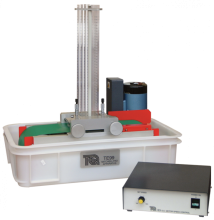Air Bearing Apparatus

Bench mounted, self contained air bearing apparatus to demonstrate the performance of self acting, gas lubricated journal bearings, including the phenomenon of half speed whirl.
This floor-standing apparatus allows students to study the performance of a journal bearing during different test conditions.
It is a plain steel shaft encased in a clear acrylic shell and directly driven by an electric motor. The bearing is freely supported on the motor shaft and sealed with a rubber diaphragm. The clearance is especially large to clearly show the oil in the bearing. Supplied with the equipment is a container of suitable oil.
A control unit adjusts the motor speed, which can run in both directions. A display shows the motor speed. An adjustable reservoir supplies oil to a low-pressure region at both ends of the bearing.
The bearing contains 12 equispaced pressure tappings around its circumference and four additional ones along its topside and on a vertical radial plane. All are connected by light and flexible plastic tubes to the rear manometer panel, to clearly show the pressure head of oil at all 16 points at all times.
Students load the bearing by attaching weights (included) to arms connected to the bearing.
A strong steel frame with a worktop holds the bearing, the motor, the manometer panel, and the control unit.

Bench mounted, self contained air bearing apparatus to demonstrate the performance of self acting, gas lubricated journal bearings, including the phenomenon of half speed whirl.

A bench mounted, self contained apparatus to demonstrate the pressure distribution across the film of oil in a Michell tilting pad slider bearing. Helps to prove Reynold's equation for pressure gradient in fluid film.

Bench mounted, self contained unit that allows a practical examination of Hertz's theories of contact between materials.
